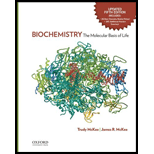Sorry! We don’t have solutions for this edition yet.
Solutions are available for other editions of this book
View 6th Edition solutionsarrow_forwardBook Details
A Review of Basic Principles. To ensure that all students are sufficiently prepared for acquiring a meaningful understanding of biochemistry, the first four chapters--now streamlined for easier coverage and self-study assessment--review the principles of relevant topics such as organic functional groups, noncovalent bonding, thermodynamics, and cell structure.
Chemical and Biological Principles in Balance. Comprehensive coverage offers each instructor the flexibility to decide how much chemistry or biology he/she would like to present. Chemical mechanisms are always presented within the physiological context of the organism.
Real-World Relevance. Because students who take the survey of biochemistry course come from a range of backgrounds and have diverse career goals, the updated fifth edition consistently demonstrates the fascinating connections between biochemical principles and the fields of medicine, nutrition, agriculture, bioengineering, and forensics.
The Most Robust Problem-Solving Program Available.
* In-chapter "Worked Problems" illustrate how quantitative problems are solved and provide students with opportunities to put their knowledge into action right when new concepts are introduced.
* Dozens of "Questions" are interspersed throughout the chapters, getting students critically thinking about high-interest topics.
* Finally, hundreds of multiple-choice and short-answer questions at the end of the chapters test students' knowledge, develop their conceptual understanding, and encourage them to apply what they have learned.
Simple, Clear Illustrations. Biochemical concepts often require a high degree of visualization, and the McKee and McKee art program brings complex processes to life. The book includes 700+ full-color figures, many newly enhanced for a more vivid presentation in three dimensions and consistent scale and color for chemical structures.
Currency. The updated fifth edition has been extensively updated with recent developments in the field, while remaining focused on the "big-picture" principles that are the focus of the one-term biochemistry course.
NEW TO THIS EDITION
285 Additional End-of-Chapter Review Questions. These bonus fill-in-the-blank and short-answer questions at the end of each chapter encourage students to test their knowledge of the material and apply what they have learned.
New Chemistry Primer. This helpful in-text resource reviews foundational general chemistry and organic chemistry topics.
New Chapter-Opening Vignettes. These nineteen essays cover many fascinating topics, including the nature and diversity of life, the ocean's dark secret life, spider silk, humans and enzymes, sweet and bitter taste in diet, metabolism and jet engines, evolution as chance and necessity, oxygen's molecular paradox, global warming and renewable energy, the Gulf dead zone, Parkinson's disease and Alzheimer's, hypertension and uric acid, what makes us human, the medical mystery of DNA and chimeras, and the superbug MRSA.
New "Biochemistry in Perspective" Boxes. These boxes show students the real-world relevance of the biochemical processes that they are studying. Each box presents an opening question and concluding summary, helping students place material in its proper context. The updated fifth edition includes new essays on cell regulation and metabolism, protein folding and human disease, quantum tunneling and catalysis, wine production, turbo design dangers, myocardial infarct, the hormone cascade system, and trapped ribosomes.
New "Biochemistry in the Lab" Boxes. Completely new to this edition, these boxes present coverage of protein sequence analysis and glycomics.
Expanded Coverage Throughout.
* Increased coverage of chemicals, and a greater focus on mechanisms
* Discussion of cutting-edge topics such as RNAi, epigenetics and the epigenome, macromolecular crowding, GLUT transporters, systems biology, and the contribution of dietary fructose to the current epidemics of obesity and type II diabetes
* Updated coverage of coenzymes, viruses, and biotechnology
* Extended coverage of amino acids, proteins, enzymes, carbohydrates, nucleic acids, and genetic information
In-Chapter "Key Concept" Lists. The text presents 100+ bulleted summaries with icons, along with 100+ icons for biomedical applications with new labels identifying the application. Other icons point to JMOL visualization software.
Show less
More Editions of This Book
Corresponding editions of this textbook are also available below:
